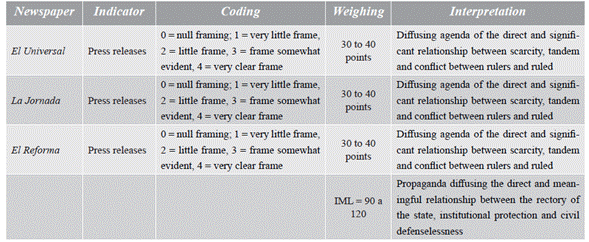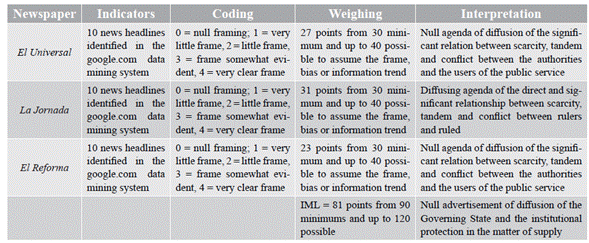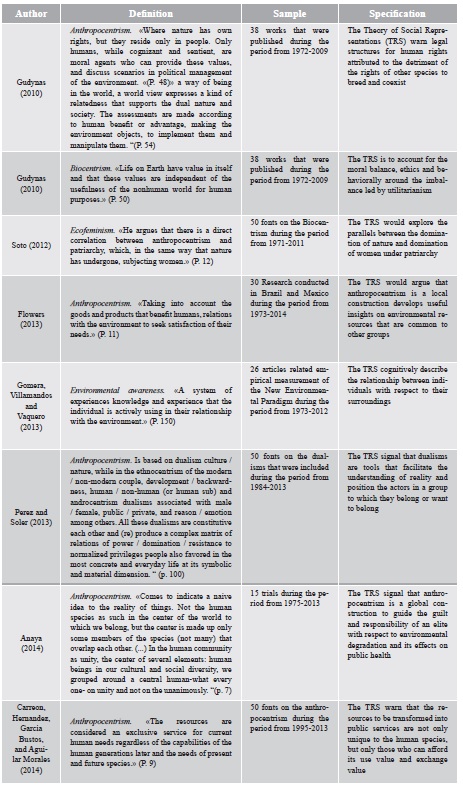Introduction
In the context of participatory democracy, the media play an important role in establishing an agenda and propaganda against or in favor of a political regime based on the security and sustainability of natural resources and public services. This is a phenomenon in which the axes and themes of discussion, established by the traditional media such as television, radio or the press, generates in the citizenship two rationalities, one informative and other inherent to the problems of natural resources and public services.
In this way, civil society as a user of public services, evaluates the performance of its authorities according to the information available in the traditional media. In this sense, the study of a problem such as scarcity, shortage or unhealthiness of water resources and services can be approached as a phenomenon of establishment of agenda and propaganda of the rectory of the state, institutional protection and civil despair.
The phenomenon in question lies not only in the establishment of an agenda and the diffusion of propaganda in the matter of scarcity, lack of supply and conflict over water use and consumption, but also in the attribution of responsibility to the State as the guiding principle of security and sustainability, as well as institutions for non-compliance with their ethics of care and the consequent attribution of defenselessness of civil society.
However, in the face of the hypothesis of State rector and civil despair, a proposal for active, deliberative and participatory citizenship emerges which rationalizes information based on credibility and truthfulness.
There are three theoretical frameworks from which the phenomenon in question has been explored: 1) theory of agenda setting, 2) theory of media culture, and 3) theory of social representations.
The agenda-setting theory points to the framing of the media as biases or systematic tendencies to disfavor or enhance the state’s leadership in matters of security and sustainability. It is a process in which the television, radio or the press focus their interest in evidencing the capacity of a government based on the popularity of its strategies and programs.
A direct consequence of the establishment of the agenda is the axes and topics of discussion in public opinion, essentially in the discourse of leaders such as communicators, analysts or columnists. From this fact, the media culture theory emphasizes the information that has been emitted by an opinion leader and its resonance in the opinion of citizens who are not experts in the axes and subjects of discussion, but who cite their leaders to construct a opinion. This phase of formation of civil opinion is known as a social representation and this consists of producing meanings around referring symbols or archetypes of information, linked to local customs, values and regional norms.
It is the case of security as the axis of discussion and central topic of debate in the agenda of traditional media, citizenship and rulers. It is possible to appreciate words like “sicario”, “ajuste de cuentas” or “lugarteniente” in the speeches of these actors, which reflect: a) the establishment of an agenda of public insecurity, b) information related to organized delinquency and c) representations of the State in the exhibitions of captured criminals or representations of the defenseless citizenship before reports of political corruption linked to drug trafficking.
The relationship between authorities and users of public services has been a central issue on the agenda of the media. In the case of water as a strategic resource for local development, quality of life and subjective well-being, in recent years it has been widely reported by the media (Anaya, 2014).
Particularly the print media with national circulation has included reports about the imbalance posed by water scarcity and water shortages associated with the corruption of local authorities and increased rates deregulated (Gomera, Villamandos, & Vaquero, 2013).
The impact of media coverage regarding the shortage and poor health has been a central issue in the public health agenda (McCombs, 1996). It is estimated that about six million children die from hydro transmitters diseases in countries with high rate of water shortages, but this means not only disseminate information but also associate the performance of the authorities in terms of management. Thus, in the suburbs of large cities the problem of water supply has been addressed by a system of tandem in which increasingly restricted water consumption and substantially increase rates (Gudynas, 2010).
Approximately 20 % of incomes in vulnerable or water exclusion situation is assigned to the purchase of water products, but print media rather highlight the lack of infrastructure and attention to contingencies such as drought or frost (Perez & Soler, 2013).
Therefore, the media have a particular view of the problem of water scarcity and lack of authority and the exoneration of users who have regular access to drinking water or who justify the consumption of soft drinks for the pharmaceutical industry.
It is a process in which the systematic dissemination of biased information regarding the relationship between availability and management of water resources is known as agenda setting (Carreon, Hernandez, Garcia, Bustos, Morales & Aguilar,2014).
An agenda is the result of the exchange of information between the agents involved, but the differences between them generates information biases that are disseminated in the media and are used to justify tariff increases by the authorities, waste by users, conflicts between actors or, in tandem or policies restricting water (Flores, 2013).However, the agenda is also historic, as it involves the reaction of organized civil society groups regarding the performance of its authorities on quality public services (García, 2011).
It is power relations that have grown but in the case of the print media is a process more complex that sets as an overview of water availability in reference to consumption human. The media presented as central theme the water problem, because the authorities responsible for the inefficiency of rates and expose closures avenues, boycotts pipe facilities or kidnappings as evidence of un-governability that inhibit local sustainable development.
The following premises address administrative corruption on supply and collection of public drinking water:
Premise 1.
The availability of resources to be scarce generates an administration of austerity and shortages financed by a steady increase in the unit price of water in terms of political relations between local governments and civil society organizations.
Premise 2.
The rates reflect political negotiations between members and militants not only with respect to election time and the proximity of local elections, but also in terms of management capabilities of civil society organizations.
Premise 3.
Conflicts between civil society and local government in the field of municipal water services reflect systematic dissemination of shortage and quality of drinking water in the media with emphasis on national newspapers.
Method
Non-experimental, retrospective, documentary and exploratory study. Notes the daily newspaper of national circulation during the period from 2010-2015. The sample of informative notes was made using the data mining technique of the search engine google.com, considering the keywords: “shortage”, “tandem”, “conflict”, “leaks”. The selected journals were: “El Universal”, “La Jornada” and “El Reforma” (see Table 1).
Instrument.
Matrix analysis of content including references consulted and processed information as shown, instruments and results (see Table 1 y Table 1A in annex).
Table No.1 Index mediatization leak

N = 30 press releases. IMF = Leverage Mediation Index established by the average of the evaluations of 10 judges with respect to press releases that framed the information about the scarcity, the tandem and the conflict between authorities and users of the potable water service, focusing the problematic in municipal and residential leaks. Source. self-made.
Procedure.
From the google.com data mining technology, press releases were identified regarding the scarcity, tandem and conflicts arising from municipal and residential water leaks. The Delphi technique was used to compare and integrate information concerning the framing of press releases. Ten expert judges were used in the problem: 3 officials, 3 journalists, 3 citizens and the evaluation of the researcher. Estimated impact of press releases considering its content and frequency of keywords or indicators of scarcity and cost of drinking water.
Validity .
The degree of coincidence between the informed deliberation and the reasoned deliberation of the judges would not affect negative or positively their economic, political and social status.
Coding.
Each one of the headings of the press releases was evaluated by the judges, considering a scale that goes from 0 = null framing to 4 = very evident framing. For example, “In Iztapalapa there is water for the next 50 years” was considered by the 10 judges as a biased header since, if it is related to the discovery of a well, its degree of contamination and water inaccessibility limit the supply even of the colony in which the well is located. Therefore, it was evaluated with 4 points.
Weighting.
The Leverage Mediation Index was established based on the average of 10 judges’ evaluations of the press releases, following the criterion of validity regarding differences and similarities between the judges’ responses. This weighting strategy allows us to move towards multivariate estimates that require averages, stands deviation and variances to establish differences between groups.
Interpretation.
Since the options “frame something evident” and “very clear frame” reflect a position in favor of considering the establishment of an agenda in each newspaper and the emergence of a propaganda by the three newspapers, the sum of these options formed a range ranging from 30 to 40 (90 to 120 for the case of summation of options 3 and 4 with respect to the total of 30 notes). It was considered that the summations inferior to the rank would reflect a null establishment of the agenda for each newspaper and consequently, a null propaganda campaign for the case of the three newspapers.
Results
Table 2 shows a synthesis related to the establishment of an agenda and propaganda regarding scarcity, tandem and conflicts over municipal and residential leaks.
It is possible to appreciate the null establishment of an agenda by El Universal and El Reforma, but in the case of La Jornada there is a bias that implies the social representation of the source of information and the problem, that would consist in associating the prestige of the newspaper with the context of scarcity, tandem and conflict between authorities and users. However, if the index is analyzed in its entirety the bias of the press does not reach a minimum level of frame that allows observing a propaganda of the State, institutional protection and the civil despair.
The weight of notes and images as well as their mutual correspondence concerning the coverage of water leaks Iztapalapashow that the items appear to be biased as they reached a total value of 4 points of 40 possible. Only in notes III (Alistan constitution water Iztapalapa) and V (is lost in leaks 35% water) reporters tried to externalize their opinion on the issue. The note V journalist quotes two officers: David Robles and Hector Reyes to support the header of your report regarding the volume is wasted by visible and invisible leaks without establishing a percentage distinction between the two issues and link it with 35% announcing at the top of the note.
Regarding framed pictures, media coverage seems to be high since it reached a total of 36 points of 44 possible. A quarter of the selected notes reached the maximum weighting relative to framing. IX and X notes included images out of context without any connection with the note. Such notes did not try to influence or confuse readers. However, the notes I, II, III, IV, V, VI, VII, VIII and XI included images that seems evident extreme shortages; public service users storing water in drums, jars and buckets, or images where principal photography leaks seem to be uncontrollable.
In the case of the relationship between discourses and images, the index was 22 Framed Hybrid which was considered moderate as only the notes III, VI, IX and X included images that did not correspond to the briefing notes.
However, the note III what headed: “Ready incorporation of water in Iztapalapa” included images of water users away. That is, “El Universal” describes a leak to argue the need for a legal agreement and illustrates his message with images relating to a possible consequence: the improvised water storage.
The results showed a moderate mediation except Framed Images Index (IEI), which was close to a high degree of media coverage. Such findings are consistent with those found by Garcia (2011) who found moderate levels of media coverage regarding the participation of users in situations of scarcity.
Finally, the index Mediatization Leak scored a total of 81 of 120 possible to settle at a moderate level. That is, the press coverage about the shortage prompted by leaks seems to have an unusual bias in relation to the description and illustration of the water situation.
Discussion
The present study to the theoretical frameworks to the establishment of the agenda and propaganda of the rectory of the State and civil defenselessness, lies in the proposal of the print media regarding the problem of scarcity, and activated conflict for municipal leaks.
However, the data provided by google.com data mining and the Dephi technique limit the results to a specific study context since it is necessary to extend the information search to the subsidy, remission or tariffs of the public service, as well as to carry out a representative study with citizens of at least two demarcations, one with high and another with low availability of water to be able to compare the findings in different contexts and samples.
With respect to the theoretical and conceptual frameworks related to the establishment of the agenda, media culture and social representation, the present work has shown that this process is partial since the IML reached a moderate level. The phenomenon of diffusion of scarcity, tandem and conflict seems to show only part of a global and extensive problem, namely: the anthropocentrism that consists in the management, distribution and consumption of water in a region or locality considering it as the exclusive patrimony of its inhabitants and rulers without considering the needs and capacities of future generations of animal and plant species.
It is necessary to include categories of anthropocentrism, biospheres or ecofeminism to be able to establish the agenda and the propaganda of the State, with respect to security and sustainability. This will allow us to anticipate scenarios of authoritarianism or informational totalitarianism, where the central agency version prevails, unilateral communication, impersonal defenselessness and unidirectional demotivation, the main indicators of a context of null civil participation.
Conclusion
The phenomenon of diffusion relative to the rectory of the State in the matter of the management of water resources and services before the scarcity, tandem and conflict exposed in the press and established as axes of discussion in a local agenda as in a campaign of conjunctural propaganda supposes: 1) the analysis of the impression or bias of the print media in a given electoral period, 2) the observation of the impact of the framing on the civil opinion, its preferences and voting intentions, and 3) the discussion concerning the level of framing of the press and its effects on the speeches of public and private actors and sectors before, during and after the local or federal elections. This exercise will allow us to infer the degree of deliberation, participation and responsibility of the civil actors regarding the information on the performance of their authorities and the reflection of their anthropocentric or biosphere logic and ethics in the supply and collection of drinking water service.
















